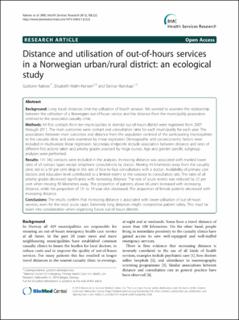| dc.contributor.author | Raknes, Guttorm | |
| dc.contributor.author | Hansen, Elisabeth Holm | |
| dc.contributor.author | Hunskaar, Steinar | |
| dc.date.accessioned | 2020-06-10T12:16:16Z | |
| dc.date.available | 2020-06-10T12:16:16Z | |
| dc.date.created | 2013-08-25T19:05:16Z | |
| dc.date.issued | 2013 | |
| dc.identifier.citation | BMC Health Services Research. 2013, 13 . Article number: 222 | en_US |
| dc.identifier.issn | 1472-6963 | |
| dc.identifier.uri | https://hdl.handle.net/11250/2657577 | |
| dc.description.abstract | Background
Long travel distances limit the utilisation of health services. We wanted to examine the relationship between the utilisation of a Norwegian out-of-hours service and the distance from the municipality population centroid to the associated casualty clinic.
Methods
All first contacts from ten municipalities in Arendal out-of-hours district were registered from 2007 through 2011. The main outcomes were contact and consultation rates for each municipality for each year. The associations between main outcomes and distance from the population centroid of the participating municipalities to the casualty clinic and were examined by linear regression. Demographic and socioeconomic factors were included in multivariate linear regression. Secondary endpoints include association between distance and rates of different first actions taken and priority grades assessed by triage nurses. Age and gender specific subgroup analyses were performed.
Results
141 342 contacts were included in the analyses. Increasing distance was associated with marked lower rates of all contact types except telephone consultations by doctor. Moving 43 kilometres away from the casualty clinic led to a 50 per cent drop in the rate of face-to-face consultations with a doctor. Availability of primary care doctors and education level contributed to a limited extent to the variance in consultation rate. The rates of all priority grades decreased significantly with increasing distance. The rate of acute events was reduced by 22 per cent when moving 50 kilometres away. The proportion of patients above 66 years increased with increasing distance, while the proportion of 13- to 19 year olds decreased. The proportion of female patients decreased with increasing distance.
Conclusions
The results confirm that increasing distance is associated with lower utilisation of out-of-hours services, even for the most acute cases. Extremely long distances might compromise patient safety. This must be taken into consideration when organising future out-of-hours districts. | en_US |
| dc.language.iso | eng | en_US |
| dc.publisher | BioMed Central (BMC) | en_US |
| dc.title | Distance and utilisation of out-of-hours services in a Norwegian urban/rural district: an ecological study | en_US |
| dc.type | Peer reviewed | en_US |
| dc.type | Journal article | en_US |
| dc.description.version | publishedVersion | en_US |
| dc.rights.holder | Open Access | en_US |
| dc.subject.nsi | VDP::Helsetjeneste- og helseadministrasjonsforskning: 806 | en_US |
| dc.subject.nsi | VDP::Health service and health administration research: 806 | en_US |
| dc.source.pagenumber | 10 | en_US |
| dc.source.volume | 13 | en_US |
| dc.source.journal | BMC Health Services Research | en_US |
| dc.identifier.doi | 10.1186/1472-6963-13-222 | |
| dc.identifier.cristin | 1044981 | |
| cristin.ispublished | true | |
| cristin.fulltext | original | |
| cristin.qualitycode | 2 | |
